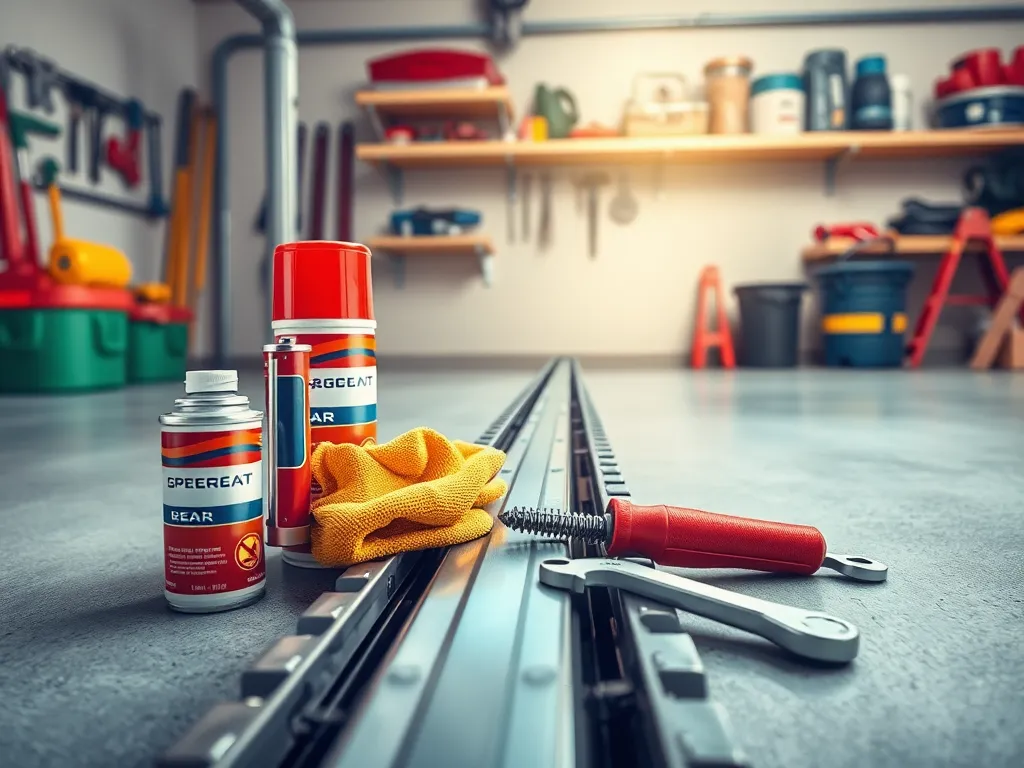Essential Step-by-Step Guide for Lubricating Garage Door Tracks

The Ultimate Guide to Lubricating Garage Door Tracks
Lubricating garage door tracks is an essential maintenance task that should not be overlooked. Just like any other mechanical parts, the tracks and components of your garage door require regular lubrication to function smoothly and effectively. Neglecting this simple task can lead to various issues, including increased wear and tear, undesired noise, and even complete malfunction of the door system.
Regular garage door maintenance ensures optimal performance and longevity, preventing costly repairs down the line.
When it comes to garage doors, they operate on a system of tracks, rollers, and other components that need to work in harmony. Lubricating garage door tracks ensures that the rollers glide smoothly, allowing the door to open and close effortlessly. Regular maintenance of these components can extend the lifespan of your garage door, minimize repair costs, and enhance its overall performance.
For homeowners seeking to enhance their garage functionality, our comprehensive track lubrication guide is an invaluable resource.
It's not just about keeping things moving. Lubricating garage door tracks also plays a significant role in ensuring safety. A well-functioning garage door can help prevent accidents or injuries caused by sudden door malfunctions. Therefore, understanding the steps and importance of lubricating garage door tracks can go a long way in maintaining your garage door’s efficiency and safety.
In this comprehensive guide, we will cover everything you need to know about lubricating garage door tracks, from materials needed, the step-by-step process, common mistakes to avoid, and how to maintain garage door tracks after lubrication. Whether you're a DIY enthusiast or a homeowner looking to maintain your garage door, this guide has you covered.
So let's delve deeper into the significance of lubricating garage door tracks and how to do it properly.
Importance of Lubricating Garage Door Tracks
Lubricating garage door tracks is crucial for maintaining the functionality and longevity of your garage door. Over time, dust, debris, and rust can accumulate in the tracks, leading to friction and difficulty in operation. Regular lubrication helps to remove this buildup and ensure the components are working effectively.
Failure to lubricate garage door tracks can lead to several common problems such as misalignment, wear and tear on the rollers, and even complete failure of the garage door system. This can result in higher repair costs and potential safety hazards.
On the flip side, the benefits of regular lubrication are numerous. Beyond smooth and quiet operation, lubrication can also reduce the strain on the garage door opener, provide better security (as a well-functioning door is less prone to be forced open), and prolong the overall life of the garage door components.
To achieve effortless operation, it's crucial to ensure smooth sliding of your garage door, particularly with frequent usage.
Materials Needed for Lubricating Garage Door Tracks
Choosing the right lubricant for your garage door tracks is paramount to ensuring an effective lubrication process. Ideally, you should look for a lubricant specifically designed for garage doors. Silicone-based lubricants are a popular choice as they offer excellent protection and do not attract dirt and dust like oil-based lubricants.
In addition to the lubricant, you will need some essential tools to aid in the lubrication process. A clean cloth or rag is crucial for wiping down the tracks, while a spray bottle or lubricant applicator can help deliver the lubricant precisely where it's needed. A step stool may also be useful to reach higher parts of the door if necessary.
Safety is key during any maintenance task. Ensure to wear protective gloves to prevent skin irritation from the lubricant. Safety goggles are also advisable to protect your eyes from any splashes or debris that might occur during the process.
Step-by-Step Process for Lubricating Garage Door Tracks
To begin, it's vital to prepare your garage door for lubrication. Start by disconnecting the garage door opener to ensure the door is not operated while you're working. Then, manually open and support the door in a way that allows easy access to the tracks and rollers.
Next, using your clean cloth, wipe down the garage door tracks to remove all dust and debris. Once clean, apply your chosen lubricant to the tracks, focusing on the areas where the rollers make contact. It's crucial to ensure that the lubricant penetrates the tracks fully and evenly.
For even lubrication across the tracks, it’s effective to apply the lubricant in a zig-zag motion along the length of the tracks. After lubricating, gently operate the garage door a few times to ensure smooth movement and to help distribute the lubricant evenly through the rollers and tracks.
Common Mistakes to Avoid When Lubricating
Over-lubricating garage door tracks can be just as problematic as under-lubricating. Excess lubricant can attract dirt and grime, which may cause more issues than it solves. Always use a moderate amount of lubricant, focusing on coverage rather than volume.
Using the wrong lubricant types can also cause unwanted problems. Avoid using grease or heavy oils, as they can attract debris and create sticky, gummed-up tracks. Stick to lubricants that are designed for garage doors and that won’t form a sticky residue.
Lastly, many homeowners neglect other parts of the garage door system that require lubrication. Remember to check the rollers, hinges, and springs, as these components also benefit from regular maintenance and lubrication for optimal performance.
Maintaining Garage Door Tracks Post-Lubrication
For optimal performance, garage door tracks should be lubricated at least twice a year. However, if you notice increased noise or significant resistance when operating the door, it may be time to reapply lubricant sooner.
Watch for signs that lubrication is wearing off, such as sluggish door movement, increased noise, or visible residue in the tracks. Regular inspections can help catch these signs early and prevent more significant issues.
In addition to lubrication, keep your garage door tracks clean and free from debris by regularly wiping them down and inspecting for any signs of wear or damage. Taking these extra steps can significantly enhance the longevity and performance of your garage door system.
